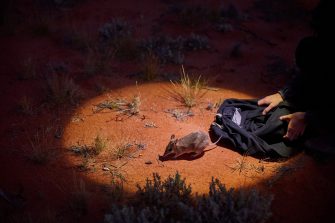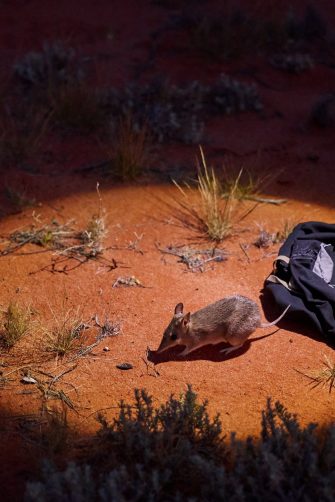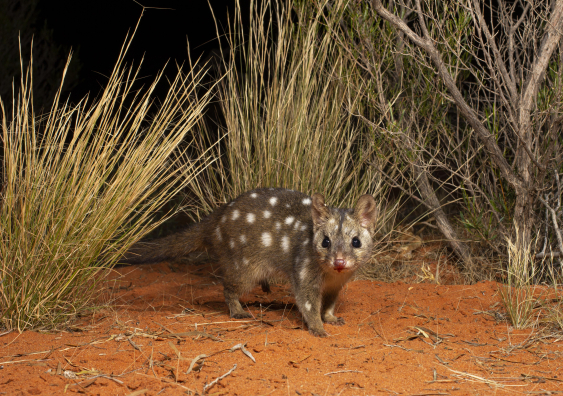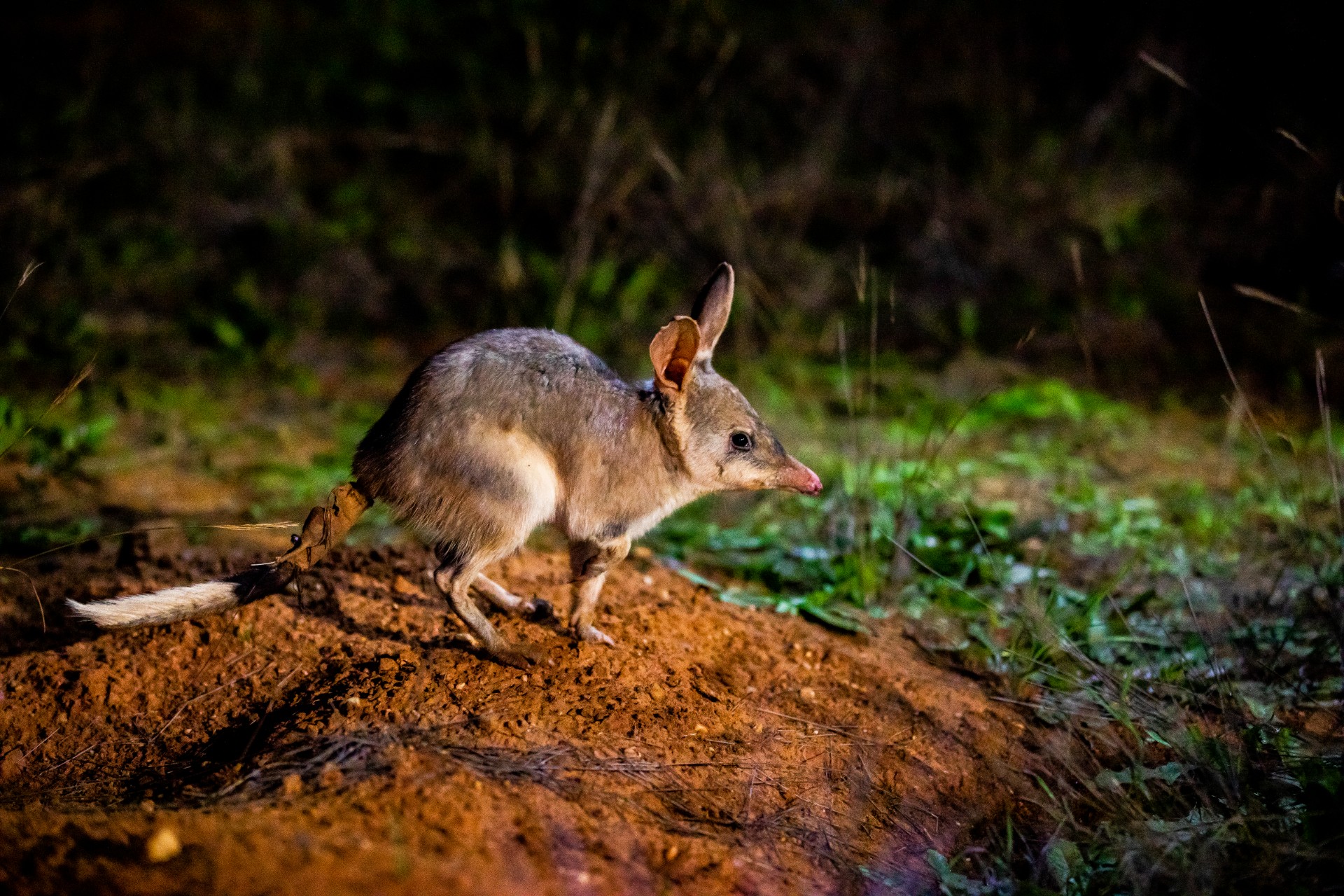UNSW conservation scientists are aiming to train threatened species to recognise and survive feral predators after focusing on feral cat control using cutting edge technology.
Quolls, bettongs and bilbies have returned to the wilds of Sturt National Park in NSW after an absence of 100 years, as part of a conservation project to translocate them ‘beyond the fence’ of a protected, feral-free area.
The project in Sturt National Park is a collaboration between the Wild Deserts Project Partnership and the NSW National Parks and Wildlife Service, with Wild Deserts Partnership including UNSW’s Centre for Ecosystem Science, Ecological Horizons, and Taronga Conservation Society Australia.
These nationally threatened species – including the western quoll Dasyurus geoffroii, burrowing bettong Bettongia lesueur and greater bilby Macrotis lagotis – became extinct in the wild in NSW about a hundred years ago, mainly because of ecosystem changes caused by rabbits and predation by feral cats and foxes.
Feral free
The team’s latest innovative work extends beyond these fenced feral free areas or safe havens in Sturt National Park. With philanthropic support, the Wild Deserts’ team has created a 10,000 ha semi-bounded area. Within this area, intensive cat and fox control has established a ‘Wild Training Zone’ – a halfway house between the safety of the fenced area and the outside Strzelecki Desert where there are high numbers of feral cats and introduced foxes.
This area provides the essential territory size for populations of western quolls, which need an average of about 400 ha. Sixteen western quolls captive bred at Taronga Western Plains Zoo in Dubbo were reintroduced in late April. Another four were also reintroduced in July from Arid Recovery, near Roxby Downs. Western quolls are the top predator in the system and reflect the focus of the project to not only reintroduce locally extinct species, but restore the desert ecosystem, including its food web.
“It has been incredibly exciting to release 20 western quolls and 100 bilbies into the Wild Training Zone area,” said UNSW's Dr Rebecca West, Principal Wild Deserts ecologist.
“Seeing their tracks in the red sand for the first time in around a century and radiotracking them daily to check their survival has been a thrill, especially as so far, they are surviving well in the training zone, where we are reducing feral cats to low numbers.“
Our previous research work on reintroduced quoll, bettong and bilby populations in arid South Australia demonstrated that bilbies, bettongs and quolls can establish with low levels of cat predation.
Survival skills
In May this year, 20 burrowing bettongs were also reintroduced from Arid Recovery. They quickly settled into their new home, establishing their extensive burrow system and breeding soon afterwards.
Feral free safe havens are a great tool to return locally extinct mammals to areas where they have become extinct. The Wild Training Zone is exactly as it sounds – an area where the team hope to train these reintroduced mammals for the wild, teaching them skills to survive in environments where cats and foxes are present. This requires management of feral predators to low levels, where they can act as a selection pressure.
UNSW Associate Professor Katherine Moseby said reducing feral animals to small numbers was key.
“Our previous research work on reintroduced quoll, bettong and bilby populations in arid South Australia demonstrated that bilbies, bettongs and quolls can establish with low levels of cat predation,” she said.
“Importantly, bettongs and bilbies quickly become more predator aware and vigilant, compared to other individuals in a cat-free exclosure.”
Conservation plan
NSW Minister for the Environment, the Honourable Penny Sharpe commented on the importance of reintroducing these threatened species back into their rightful place to improve the conservation outcomes of our National Parks.
“These are the first western quolls in NSW for almost a century and the 13th locally extinct mammal returned across NSW,” Minister Sharpe said.
“It’s a big moment in our quest to reverse the loss of biodiversity across NSW.
“This is not just about the return of individual species. It is about restoring ecosystems which depend on bilbies, bettongs and other ecosystem engineers to support the landscape by digging, spreading seeds and boosting water and nutrient cycles.
“The Minns Labor Government is committed to protecting what’s left and restoring what has been harmed, and it’s wonderful to see this in action in Sturt National Park.
“We are fortunate to partner with amazing scientists and researchers from UNSW’s Centre for Ecosystem Science and Ecological Horizons and Taronga Conservation Society and we thank them for their important work.”
New technologies
The work in Sturt National Park is restoring the ecosystem with threatened species that once roamed there, along with reducing extinction risks to other species such as dusky hopping mice. Most importantly, it aims to build on getting these mammals beyond the fences, requiring effective control of cats over an extensive area and for bilbies, bettongs and quolls to learn antipredator avoidance techniques. If successful, there are enormous implications for releasing threatened species in other parts of Sturt National Park and also other deserts in Australia.
Federal Minister for the Environment and Water, Tanya Plibersek, said on a recent visit to the Wild Deserts Project area in Sturt National Park that it was particularly encouraging to see some real-world testing of some of the new technologies that the Australian Government is investing in such as the Felixer groom traps for controlling cats.
“Australia has the worst mammal extinction rate in the world,” Minister Plibersek said.
“Feral cats are implicated in at least two-thirds of those mammal extinctions and threaten another 200 mammal, bird, reptile and frog species across Australia. The Australian Government has invested $60 million in projects to stop feral cats in their tracks, including a range of ‘beyond the fence’ initiatives such as traps equipped with artificial intelligence, drone-based thermal cameras and eDNA technologies and feral cat detector dogs.”
Project Co-ordinator of the Wild Deserts Partnership, UNSW's Dr Reece Pedler, underlined the importance of this initiative and its planning.
“A huge amount of work has gone in during the last few years to get us to this exciting stage. We have intensively controlled feral cats with a range of tools, including innovative devices such as Felixer grooming traps. This has involved late nights and early mornings for effective control and ensuring the threatened species have established. Getting the balance right will be key to the success of this really exciting initiative.”
Emotional moment
"It was overwhelmingly emotional to see the bilbies released back on Country," Taragara Researchers Dr Lorina L. Barker, Aunty Gwen Barker, Leroy Barker and Dr Eliza Kent said in a statement from Taragara Aboriginal Corporation.
"It is important for both the Country and for people. Wild Deserts is an example of what it means to work together with partner organisations and Traditional Owner groups, and to achieve great things in the Caring for Country, along the Songlines of Country."
Katherine Tuft, Chief Executive of Arid Recovery said: “We’re delighted to partner with Wild Deserts in returning missing species like these bettongs and quolls. Our desert ecosystems and communities are richer for their return.”
Such a large project has depended on the strength of the partnership between the Wild Deserts team and other collaborators.
“It has been fantastic to work with our project partners in realising this ambitious plan,” said Professor Richard Kingsford, leader of the Wild Deserts Project and Director of the UNSW Centre for Ecosystem Science.
“We could not have done this without the bilbies and quolls we have released into the wild from Taronga Conservation Society Australia and bilbies, quolls and bettongs from Arid Recovery."
Over the coming months and years, the team will continue to work to monitor the released mammals and to manage cat densities in the area. Ensuring that threatened species continue to survive in Australian deserts under pressure from feral cats and foxes is a big challenge. The team is using the innovative and cutting-edge research to make it a more even fight for our threatened species.
Bred for success
Taronga Conservation Society Australia CEO Cameron Kerr AO said the team is incredibly proud of its vital conservation breeding program for the endangered western quoll.
“In just three years, with the support of essential philanthropic funding, Taronga has produced 90 quolls for release, including 44 animals from this year’s cohort that are now fit and ready to be released back into the wild,” he said.
“The release of 16 western quoll into Wild Deserts marks the return of this species to NSW. This remarkable achievement is a testament to Taronga’s multidisciplinary conservation team, working across the Taronga Sanctuary in Dubbo and Taronga Zoo Sydney.
“With the last recorded western quoll in NSW dating to 1841, this species is now being brought back from the brink thanks to the collaborative efforts of Taronga, our partners, and supporters.”
The release of western quoll into Wild Deserts is the second time Taronga has reintroduced a mammal species to Sturt National Park, following the successful return of Bilbies to the same region in 2020, more than a century after they were declared extinct.
The Wild Deserts project is part of a major NSW Government initiative to protect threatened native mammals through the Feral Predator Free Partnership Program. It is a collaboration between the Wild Deserts Partnership and NSW National Parks and Wildlife Service with the Wild Deserts Partnership including UNSW Sydney, Ecological Horizons and Taronga Conservation Society Australia. Funding is provided by the NSW Government under their Feral Predator Free Partnership, with matching funding from UNSW Sydney, philanthropic sources and other projects. Taronga Conservation Society Australia funded zoo-based breeding of quolls using philanthropic sources.









